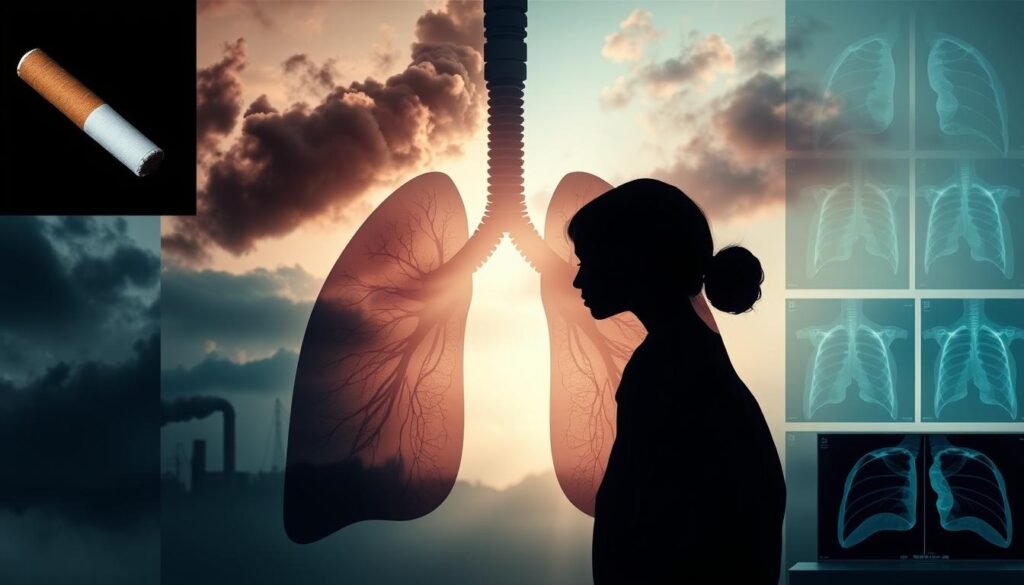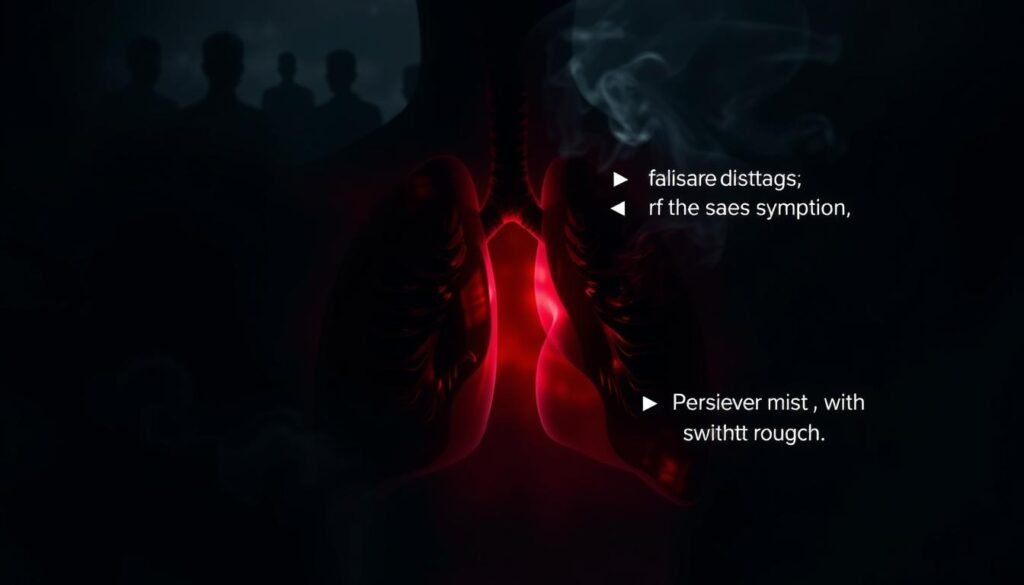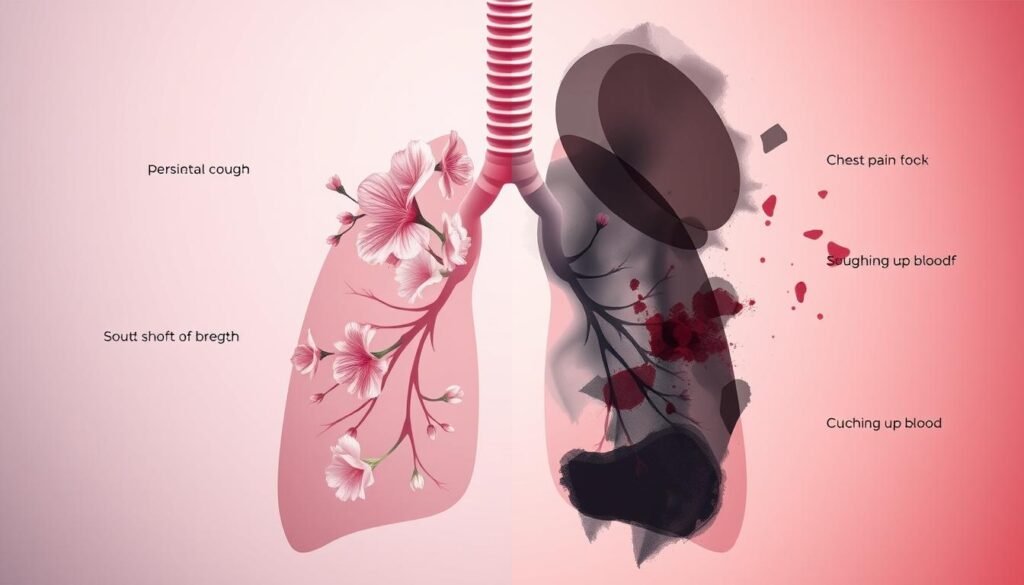Did you know smoking causes 80% of lung cancer deaths in women? Yet, most of the time, we talk more about men and lung cancer. This leaves many women in the dark about the dangers they face. It’s important for women to know the early signs of lung cancer. Catching these signs early can make a big difference in treatment and survival chances. This article is here to help women know more about lung cancer symptoms. By knowing these, women can spot them early and seek medical help sooner.
Key Takeaways
- Smoking greatly raises a woman’s chance of getting lung cancer.
- Many symptoms of lung cancer, like a long-lasting cough, might not seem serious but are.
- Lung cancer can also happen to people who don’t smoke, especially if they’re around second-hand smoke a lot.
- Knowing the signs of lung cancer that are more common in women can lead to an earlier diagnosis.
- Women might show different lung cancer symptoms than men. Being aware of this is crucial.
- It’s vital to have regular check-ups and pay attention to any changes in your health.
- There are treatments available, and finding lung cancer early can lead to better results.
Understanding Lung Cancer in Women
Lung cancer is the top cause of cancer-related deaths globally, and it profoundly impacts women. Studies show gender differences in lung cancer, highlighting unique risk factors for women. This challenges the old view that only older men who smoke get this disease.
Many factors play a role in lung cancer among women, such as hormones and the environment. A key point is that lung adenocarcinoma is common in women, even those who have never smoked. The fact that about 70% of young women with lung cancer are lifelong is important. It shows why we need to be more aware of this disease in women.
There’s a clear gender gap in lung cancer diagnosis rates. Women usually find out they have lung cancer when it’s more advanced. Their tumors are also more likely to have spread to places like bones or the brain. Knowing early signs like tiredness and breathing troubles is key to better outcomes.
The risk for lung cancer goes up with exposure to harmful substances like asbestos and radon. Genetics also matter in lung cancer risk. People with a family history of lung cancer have higher chances of getting it themselves. This information is crucial for better prevention and education on women lung cancer.
Rising Trends in Lung Cancer Diagnosis
Lung cancer rates in women have been climbing. This is a big concern for everyone’s health. Over the last 40 years, lung cancer cases in women jumped by 84%. But for men, the numbers tell a different story—their diagnoses fell by 36%. Even though smoking is a huge risk, about 20% of women with lung cancer never smoked.
This surge means young women, those under 54, are more likely to get lung cancer than men their age. In wealthy countries, lung cancer is rising fast among women aged 35 to 54. This shows we need better awareness and ways to catch the disease early. Surprisingly, non-smoking women are twice as likely to get lung cancer as non-smoking men.
In 2023, about 238,340 women are expected to face new lung cancer cases. This shows the need for close watch and regular checks for those at risk. As more people learn about this issue, doctors and the health world must step up. They need to get better at finding, stopping, and treating lung cancer in women. Doing so could save many lives.
| Year | Lung Cancer Incidence (Women) | Lung Cancer Incidence (Men) | Percentage Change (Women) | Percentage Change (Men) |
|---|---|---|---|---|
| 1973 | Data Not Available | Data Not Available | N/A | N/A |
| 2012 | Estimated 109,690 | Estimated 72,590 | N/A | N/A |
| 2023 | Approx. 238,340 | Data Not Available | N/A | N/A |
Lung Cancer Signs in Women
Lung cancer can show up through different signs that might not be obvious. It’s really important to know these lung cancer signs in women. This way, you can seek medical help and treatment quickly.
Common Symptoms to Recognize
Many women have symptoms of lung cancer that are the same for both men and women. For women, some common lung cancer symptoms include:
- Persistent cough that sticks around.
- Chest pain that gets worse when you breathe deeply or cough.
- Shortness of breath with light activities.
- Unexplained weight loss not linked to dieting.
Knowing these symptoms can really help spot lung cancer early. For more info on how to recognize different symptoms, you might want to check this useful resource.
Unique Symptoms in Females
Women might see some lung cancer signs that are not common in men. Some special symptoms include:
- Hoarseness that keeps up, possibly pointing to vocal cord issues.
- Frequent respiratory infections, which could show lung problems.
- Back and shoulder pain more often, possibly from tumors or spreading cancer.
Noticing these specific signs of lung cancer in females helps tell apart normal conditions from serious health problems. Getting early advice from doctors can really make a difference.
Risk Factors for Lung Cancer
Lung cancer is a major issue, especially for women. It’s crucial to know what increases its risk. Smoking is the top cause, but environment and genes also play big roles.
Impact of Smoking and Secondhand Smoke
Smoking is closely linked to about 90% of lung cancers. Even secondhand smoke is dangerous. It especially puts women at risk, showing why smoke-free places matter.
Other Environmental and Genetic Factors
There are many environmental hazards like radon, asbestos, and industrial chemicals. These increase lung cancer risk, more so for smokers. Family history also doubles the chance of getting it. Certain genes make lung cancer more likely and affect men and women differently.
Estrogen might also play a role in lung cancer. Things like hormone therapies, menstruation, and pregnancy could influence risk. By understanding all these factors, we can work on prevention.
| Risk Factor | Description |
|---|---|
| Smoking | Accounts for approximately 90% of lung cancer cases. |
| Secondhand Smoke | Increases risk significantly for non-smokers. |
| Radon Exposure | Linked to about 30% of lung cancer deaths among non-smokers. |
| Asbestos | Chronic exposure increases risk, particularly in smokers. |
| Genetics | Certain genes may heighten risk, contributing to disparities in lung cancer rates. |
| Family History | Individuals with a family history are twice as likely to develop lung cancer. |
| Pollution | Outdoor air pollution, including diesel exhaust, raises lung cancer risk. |

Early Signs of Lung Cancer in Women
The path to identifying lung cancer starts with noticing the small signs. Women may experience mild symptoms that are easy to ignore. These include ongoing coughs, feeling very tired for no reason, and wheezing now and then.
It’s easy for women to miss these hints or think they’re not serious. But, it’s critical to be aware and get health check-ups regularly. This can help catch lung cancer early when it’s more treatable.
Sometimes, certain symptoms like getting bronchial infections a lot, coughing up blood, and feeling out of breath without reason stand out. Spotting these early can lead to quick action and better treatment success.
Advanced Lung Cancer Symptoms
Late-stage lung cancer brings a variety of severe symptoms. It’s critical to recognize these signs early for effective treatment. When these symptoms start to show, it often means the cancer is advancing. Knowing what symptoms to look for helps in managing the disease better.
What to Look for in Later Stages
As lung cancer advances, certain signs become more evident, greatly affecting daily routines. Key symptoms to be aware of include:
- Severe bone pain
- Jaundice (yellowing of the skin and eyes)
- Neurological changes, including dizziness and weakness
- Noticeable lumps in the neck or other areas
Physical Changes to Monitor
Keeping an eye on physical changes is crucial when dealing with late-stage lung cancer. Important changes to monitor include:
| Change | Possible Implication |
|---|---|
| Unexplained weight loss | Potential worsening of cancer condition |
| Chronic coughing | Possible affectation of lung function |
| Shortness of breath | Indicates declining respiratory health |
| Increased fatigue | Sign of extensive body stress |

How to Differentiate Between Symptoms
Lung cancer often has similar symptoms to other respiratory issues. It makes spotting lung cancer signs difficult. Early-stage lung cancer might not show clear symptoms. This can lead to late diagnoses. It’s important to know the distinguishing lung cancer signs to seek medical advice early.
To understand symptoms better, consider these points:
- Duration of symptoms: A cough that lasts more than three weeks needs checking.
- Presence of blood: Coughing up blood or rust-colored spit is a key lung cancer sign.
- Unexplained weight loss: Dropping 10 pounds or more unexpectedly could mean something serious.
- Changes in breathing: Difficulty breathing or wheezing are important symptoms to note.
For more details on lung cancer symptoms, visit this source. Knowing about these symptoms and what they could mean is crucial. It helps with getting diagnosed and treated early.

Knowing and recognizing these signs can help improve treatment success for those at risk. Raising awareness about distinguishing lung cancer signs lets women and their families seek early assistance. This can greatly help their health journey.
| Symptom | Commonality | Requires Evaluation |
|---|---|---|
| Persistent cough | High | Yes |
| Coughing up blood | Moderate | Yes |
| Chest discomfort | Moderate | Yes |
| Wheezing | High | Yes |
| Unexplained weight loss | High | Yes |
Lung Cancer Detection in Females
Finding lung cancer early in females is crucial for better outcomes. Knowing the risk factors and how to screen effectively helps a lot. Women over 50 who smoke should be extra careful to get their screenings on time. These tests can find lung cancer when it’s easier to treat.
Importance of Early Diagnosis
Finding lung cancer early is very important. With more women getting this disease, doctors must use the best imaging and tools. The USPSTF suggests yearly screenings for women at risk, like those who have smoked for a long time.
Finding it early helps treatment work better. Despite some women never smoking, 20% get lung cancer. This shows all women need to be aware, even if they don’t smoke. Women usually get a type of lung cancer that’s easier to treat if found early.
| Detection Method | Benefits | Recommended For |
|---|---|---|
| Low-Dose CT Scan | Higher sensitivity for early-stage lung cancer | Women aged 50-80 with a significant smoking history |
| Chest X-Ray | Standard imaging for initial concerns | Women with respiratory symptoms or significant risk factors |
| Bronchoscopy | Direct visualization for suspicious lesions | Women with abnormal imaging results |
Telling women about lung cancer and getting screened in time is key. Teaching them about risks and promoting regular health checks can greatly help. It can improve survival rates and the success of treatments.
Emotional and Psychological Impact
Lung cancer diagnosis can be very tough emotionally for women. It greatly affects their mental health. Studies show emotional distress is common in lung cancer patients, higher than in other cancers. Rates are at 43.4%.
This stress is made worse by age, smoking status, and health level. A mix of feelings needs good coping methods.
Dealing with a Diagnosis
Women with lung cancer may feel scared, anxious, or depressed. Support is key to help them deal with these emotions. It helps them keep control over their health.
Support systems are crucial in handling lung cancer’s emotional toll.
- Support groups provide a platform for sharing experiences and feelings with others facing similar challenges.
- Counseling services allow patients to discuss their emotional responses with trained professionals.
- Therapeutic interventions, such as cognitive-behavioral therapy, can help in developing coping strategies and improving overall mental health.
Positive mental health is important for a better life quality. Knowing about their cancer and treatment helps patients manage feelings. This leads to sticking better to treatment plans. Tackling depression early is key to protect health and life quality.
| Emotional Challenges | Symptoms | Potential Support Strategies |
|---|---|---|
| Anxiety | Rapid heartbeat, sleep disturbances, difficulty concentrating | Counseling, relaxation techniques |
| Depression | Persistent sadness, emotional numbness, fatigue | Therapy, support groups, medication |
| Fear | Increased worry about treatment and prognosis | Education on treatment options, patient advocacy |
Patient care that meets emotional and psychological needs improves results. Using resources helps lessen distress and boosts coping skills.
Treatment Options for Women with Lung Cancer
Treating lung cancer involves a team approach, aimed at meeting each woman’s needs. Patients might get surgery, chemotherapy, radiation, or targeted therapy. In early stages, sometimes just surgery, like segmentectomy, is enough to tackle stage 0 non-small cell lung cancer (NSCLC).
Women facing lung cancer have unique hurdles. Studies show they do better with certain treatment mixes. Getting personal care from thoracic experts helps in beating the disease.
When lung cancer is advanced, treatments get more complex. Doctors often use chemotherapy after surgery to kill leftover cancer cells. There’s also stereotactic body radiotherapy for small or spread cancers. Immunotherapy boosts the immune fight against cancer effectively.
Palliative care is key in lung cancer treatment. It aims to better life quality by easing symptoms. Palliative care, along with other treatments, boosts well-being and might extend life.
As treatments for lung cancer advance, teamwork among doctors is vital. Women with lung cancer should explore all options to find the best treatment for them.
Advocacy and Support Resources
Many groups focus on lung cancer advocacy and offer support resources for lung cancer patients. They help patients by providing educational materials, financial aid, and clinical trial access. These groups give women the tools to take charge of their health and connect with others who understand their situation.
The American Cancer Society is a leader in support services. They have a 24/7 cancer helpline at 1-800-227-2345 for quick help. Their ACS CARES™ program gives patients and caregivers support and info that meets their specific needs.
Organizations tackle the practical difficulties of treatment. The Hope Lodge and Extended Stay America offer lodging grants to lower costs. The Road To Recovery program pairs patients with volunteer drivers. This helps them get to their treatment appointments.
| Resource | Type of Support | Contact Information |
|---|---|---|
| American Cancer Society | 24/7 Helpline, CARES™ program | 1-800-227-2345 |
| Hope Lodge | Lodging grants | Visit American Cancer Society website |
| Road To Recovery | Transportation assistance | Local American Cancer Society office |
| Cancer Survivors Network | Online support community | Visit Cancer Survivors Network website |
| EverYou™ | Wigs, headwear, surgical products | Visit EverYou™ website |
| Giving Docs | Free estate planning essentials | Visit Giving Docs website |
Women dealing with lung cancer have access to beneficial resources. These resources improve their treatment experience and overall well-being. By getting involved with these groups, they build resilience and find a community ready to support them through tough times.
Conclusion
The conclusion on lung cancer in women highlights the need to spot signs and grasp the risk factors. Signs like chronic cough and bloody sputum, along with chest pain and shortness of breath, are common. It’s vital to keep women’s health at the forefront when discussing lung cancer.
Raising awareness of lung cancer signs in women is key for early diagnosis and better treatment results. Surveys show teaching women about lung cancer’s unique signs is vital. Women need to talk openly about their health, get regular check-ups, and think about screenings.
These steps are essential for effective lung cancer management and prevention. They boost both awareness and understanding in tackling this major health challenge.
Although challenges remain in reducing the lung cancer gap between men and women, dedication to education and awareness can help. By pushing for better understanding and early detection, we can fight lung cancer’s stigma. This improves women’s health significantly.